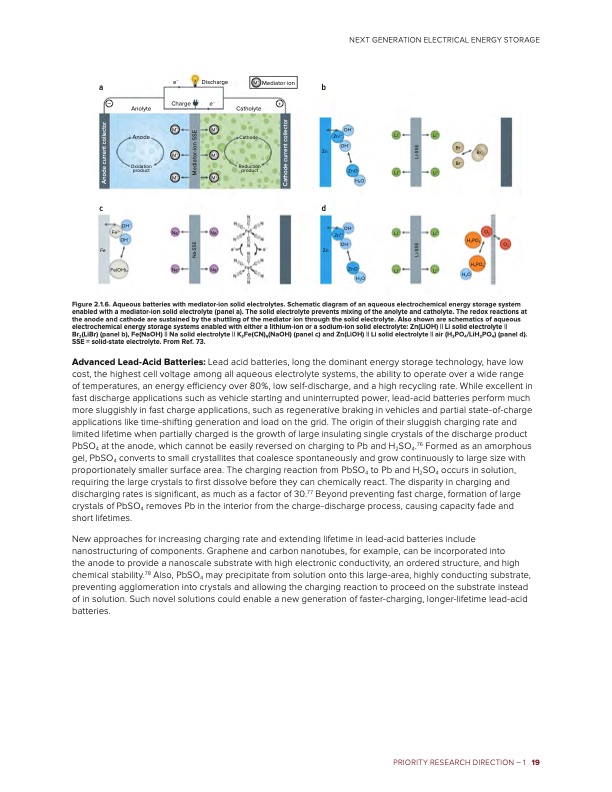
PDF Publication Title:
Text from PDF Page: 025
Anolyte Catholyte + M+ M+ Anode Cathode Zn2+ Li+ Oxidation product Reduction product ZnO Li+ H2O OH– Zn2+ Li+ OH– ZnO Li+ H2O M+M+ Zn OH– OH– Li+ Br– Br– Li+ Li+ O2 H3PO4 M+ M+ cd OH– Fe2+ Na+ Na+ OH– Fe Fe(OH)2 Na+ Na+ Zn O2 M+ Mediator ion Figure 2.1.6. Aqueous batteries with mediator-ion solid electrolytes. Schematic diagram of an aqueous electrochemical energy storage system enabled with a mediator-ion solid electrolyte (panel a). The solid electrolyte prevents mixing of the anolyte and catholyte. The redox reactions at the anode and cathode are sustained by the shuttling of the mediator ion through the solid electrolyte. Also shown are schematics of aqueous electrochemical energy storage systems enabled with either a lithium-ion or a sodium-ion solid electrolyte: Zn(LiOH) || Li solid electrolyte || Br2(LiBr) (panel b), Fe(NaOH) || Na solid electrolyte || K3Fe(CN)6(NaOH) (panel c) and Zn(LiOH) || Li solid electrolyte || air (H3PO4/LiH2PO4) (panel d). SSE = solid-state electrolyte. From Ref. 73. Advanced Lead-Acid Batteries: Lead acid batteries, long the dominant energy storage technology, have low cost, the highest cell voltage among all aqueous electrolyte systems, the ability to operate over a wide range of temperatures, an energy efficiency over 80%, low self-discharge, and a high recycling rate. While excellent in fast discharge applications such as vehicle starting and uninterrupted power, lead-acid batteries perform much more sluggishly in fast charge applications, such as regenerative braking in vehicles and partial state-of-charge applications like time-shifting generation and load on the grid. The origin of their sluggish charging rate and limited lifetime when partially charged is the growth of large insulating single crystals of the discharge product PbSO4 at the anode, which cannot be easily reversed on charging to Pb and H2SO4.76 Formed as an amorphous gel, PbSO4 converts to small crystallites that coalesce spontaneously and grow continuously to large size with proportionately smaller surface area. The charging reaction from PbSO4 to Pb and H2SO4 occurs in solution, requiring the large crystals to first dissolve before they can chemically react. The disparity in charging and discharging rates is significant, as much as a factor of 30.77 Beyond preventing fast charge, formation of large crystals of PbSO4 removes Pb in the interior from the charge-discharge process, causing capacity fade and short lifetimes. New approaches for increasing charging rate and extending lifetime in lead-acid batteries include nanostructuring of components. Graphene and carbon nanotubes, for example, can be incorporated into the anode to provide a nanoscale substrate with high electronic conductivity, an ordered structure, and high chemical stability.78 Also, PbSO4 may precipitate from solution onto this large-area, highly conducting substrate, preventing agglomeration into crystals and allowing the charging reaction to proceed on the substrate instead of in solution. Such novel solutions could enable a new generation of faster-charging, longer-lifetime lead-acid batteries. NEXT GENERATION ELECTRICAL ENERGY STORAGE a – e– Discharge Charge e– b Li+ H3PO4– H2O PRIORITY RESEARCH DIRECTION – 1 19 Br2 Na-SSE Mediator-ion SSE Li-SSE Li-SSE Anode current collector Cathode current collectorPDF Image | Next Generation Electrical Energy Storage

PDF Search Title:
Next Generation Electrical Energy StorageOriginal File Name Searched:
BRN-NGEES_rpt-low-res.pdfDIY PDF Search: Google It | Yahoo | Bing
Sulfur Deposition on Carbon Nanofibers using Supercritical CO2 Sulfur Deposition on Carbon Nanofibers using Supercritical CO2. Gamma sulfur also known as mother of pearl sulfur and nacreous sulfur... More Info
CO2 Organic Rankine Cycle Experimenter Platform The supercritical CO2 phase change system is both a heat pump and organic rankine cycle which can be used for those purposes and as a supercritical extractor for advanced subcritical and supercritical extraction technology. Uses include producing nanoparticles, precious metal CO2 extraction, lithium battery recycling, and other applications... More Info
| CONTACT TEL: 608-238-6001 Email: greg@infinityturbine.com | RSS | AMP |